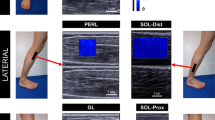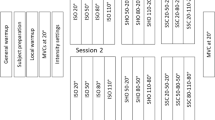Abstract
It is commonly accepted that the passive musculo-articular complex (MAC) displays a viscoelastic behavior. However, the viscosity of the MAC is still not well understood when considering the relationship between the passive resistance offered by the MAC and the stretching velocity. Therefore, in order to obtain a better knowledge of the mechanical behavior of the passive MAC, nine subjects performed passive knee extension/flexion cycles with the hip angle set at 60° on a Biodex® dynamometer at 5°, 30°, 60°, 90° and 120° s−1 in a randomized order to 80% of their maximal range of motion. Results show significant (P < 0.001) increases with the stretching velocity for the passive torque (between +17.6 and +20.8% depending on the considered knee angle), the potential elastic energy stored during the loading (E: +22.7%), and the dissipation coefficient (DC: +22.8%). These results suggest that the role of viscosity in the MAC’s mechanical behavior is limited. A linear model was well-fitted on torque-velocity (0.93 < R 2 < 0.98), E-velocity (R 2 = 0.93) and DC-velocity (R 2 = 0.99) relationships. The linear relationship between DC and velocity indicates that the DC does not tend towards zero for the slowest velocities and that the dissipative properties of the MAC could be modeled by combining linear viscosity and friction. The present study would allow the implementation of a rheological model to simulate the behavior of the passive MAC.






Similar content being viewed by others
References
Aagaard P, Simonsen EB, Trolle M, Bangsbo J, Klausen K (1995) Isokinetic hamstring/quadriceps strength ratio: influence from joint angular velocity, gravity correction and contraction mode. Acta Physiol Scand 154:421–427
Amankwah K, Triolo RJ, Kirsch R (2004) Effects of spinal cord injury on lower-limb passive joint moments revealed througth a nonlinear viscoelastic model. J Rehabil Res Dev 41:15–32
Bressel E, McNair PJ (2001) Biomechanical behavior of the plantar flexor muscle-tendon unit after an Achilles tendon rupture. Am J Sports Med 29:321–326
Bressel E, Larsen BT, McNair PJ, Cronin J (2004) Ankle joint proprioception and passive mechanical properties of the calf muscles after an Achilles tendon rupture: a comparison with matched controls. Clin Biomech (Bristol, Avon) 19:284–291
Dumas R, Aissaoui R, Mitton D, Skalli W, de Guise JA (2005) Personalized body segment parameters from biplanar low-dose radiography. IEEE Trans Biomed Eng 52:1756–1763
Esteki A, Mansour JM (1996) An experimentally based nonlinear viscoelastic model of passive joint moment. J Biomech 29:443–450
Fung YC (1983) Biomechanics. Mechanical properties of living tissues. Springer, Berlin
Gajdosik RL (2001) Passive extensibility of skeletal muscle: review of the literature with clinical implications. Clin Biomech 16:87–101
Gajdosik RL, Vander Linden DW, McNair PJ, Riggin TJ, Albertson JS, Mattick DJ, Wegley JC (2004) Slow passive stretch and release characteristics of the calf muscles of older women with limited dorsiflexion range of motion. Clin Biomech (Bristol, Avon) 19:398–406
Gajdosik RL, Vander Linden DW, McNair PJ, Riggin TJ, Albertson JS, Mattick DJ, Wegley JC (2005) Viscoelastic properties of short calf muscle-tendon units of older women: effects of slow and fast passive dorsiflexion stretches in vivo. Eur J Appl Physiol 95:131–139
Hermens HJ, Freriks B, Disselhorst-Klug C, Rau G (2000) Development of recommendations for SEMG sensors and sensor placement procedures. J Electromyogr Kinesiol 10:361–374
Hufschmidt A, Mauritz KH (1985) Chronic transformation of muscle in spasticity: a peripheral contribution to increased tone. J Neurol Neurosurg Psychiatry 48:676–685
Lamontagne A, Malouin F, Richards CL, Dumas F (1997) Impaired viscoelastic behavior of spastic plantarflexors during passive stretch at different velocities. Clin Biomech 12:508–515
Magnusson SP (1998) Passive properties of human skeletal muscle during stretch maneuvers. A review. Scand J Med Sci Sports 8:65–77
Magnusson SP, Simonsen EB, Aagaard P, Gleim GW, McHugh MP, Kjaer M (1995) Viscoelastic response to repeated static stretching in the human hamstring muscle. Scand J Med Sci Sports 5:342–347
Magnusson SP, Simonsen EB, Aagaard P, Kjaer M (1996a) Biomechanical responses to repeated stretches in human hamstring muscle in vivo. Am J Sports Med 24:622–628
Magnusson SP, Simonsen EB, Aagaard P, Sorensen H, Kjaer M (1996b) A mechanism for altered flexibility in human skeletal muscle. J Physiol 497(Pt 1):291–298
Magnusson SP, Aagard P, Simonsen E, Bojsen-Moller F (1998) A biomechanical evaluation of cyclic and static stretch in human skeletal muscle. Int J Sports Med 19:310–316
Magnusson SP, Aagaard P, Larsson B, Kjaer M (2000a) Passive energy absorption by human muscle-tendon unit is unaffected by increase in intramuscular temperature. J Appl Physiol 88:1215–1220
Magnusson SP, Aagaard P, Nielson JJ (2000b) Passive energy return after repeated stretches of the hamstring muscle-tendon unit. Med Sci Sports Exerc 32:1160–1164
Mandel J (1969) Aperçu sur les principaux comportements rhélogiques. In: Persoz B (ed) La rhéololgie. Masson & Cie, Paris, pp 1–17
McFaull SR, Lamontagne A (1998) In vivo measurement of the passive viscoelastic properties of the human knee joint. Hum Mov Sci 17:139–165
McNair PJ, Portero P (2005) Using isokinetic dynamometers for measurements associated with tissue extensibility. Isokinet Exerc Sci 13:53–56
McNair PJ, Dombroski EW, Hewson DJ, Stanley SN (2001) Stretching at the ankle joint: viscoelastic responses to holds and continuous passive motion. Med Sci Sports Exerc 33:354–358
McNair PJ, Hewson DJ, Dombroski E, Stanley SN (2002) Stiffness and passive peak force changes at the ankle joint: the effect of different joint angular velocities. Clin Biomech (Bristol, Avon) 17:536–540
Nordez A, Cornu C, McNair P (2006) Acute effects of static stretching on passive stiffness of the hamstring muscles calculated using different mathematical models. Clin Biomech 21:755–760
Nordez A, Casari P, Cornu C (2008a) Accuracy of Biodex system 3 pro isokinetic dynamometer in passive mode. Med Eng Phys
Nordez A, McNair PJ, Casari P, Cornu C (2008b) Acute changes in hamstrings musculo-articular dissipative properties induced by cyclic and static stretching. Int J Sports Med
Persoz B (1960) Introduction à l’étude de la rhéologie. Dunod, Paris, France
Rabita G, Dupont L, Thevenon A, Lensel-Corbeil G, Pérot C, Vanvelcenaher J (2005) Quantitative assessement of the velocity-dependent increase in resistance to passive stretch in spastic platarflexors. Clin Biomech 20:745–753
Reid DA, McNair PJ (2004) Passive force, angle, and stiffness changes after stretching of hamstring muscles. Med Sci Sports Exerc 36:1944–1948
Riemann BL, DeMont RG, Ryu K, Lephart SM (2001) The effects of sex, joint angle, and the gastrocnemius muscle on passive ankle joint complex stiffness. J Athl Train 36:369–375
Singer BJ, Dunne JW, Singer KP, Allison GT (2003) Velocity dependent passive platarflexor resistive torque in patients with acquired brain injury. Clin Biomech 18:157–165
Taylor CD, Dalton JD, Seaber AV, Garrett WE (1990) Viscoelastic properties of muscle-tendon units. The biomechanical effetcts of stretching. Am J Sports Med 18:300–309
Zatsiorski V (1998) Kinematics of human motion. Human Kinetics, Champaign
Acknowledgments
The authors thank Jacques Guilbaud for correcting the English and Michel Roche for his technical assistance.
Author information
Authors and Affiliations
Corresponding author
Rights and permissions
About this article
Cite this article
Nordez, A., Casari, P. & Cornu, C. Effects of stretching velocity on passive resistance developed by the knee musculo-articular complex: contributions of frictional and viscoelastic behaviours. Eur J Appl Physiol 103, 243–250 (2008). https://doi.org/10.1007/s00421-008-0695-9
Accepted:
Published:
Issue Date:
DOI: https://doi.org/10.1007/s00421-008-0695-9




